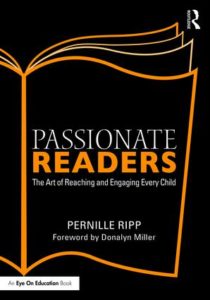The Art of Reaching and Engaging Every Reader
Passionate Readers: The Art of Reaching and Engaging Every Child
By Pernille Ripp
(Routledge/Eye On Education, 2018 – Learn more)

In Passionate Readers Pernille Ripp sets a lofty goal to cultivate and guide the passion for reading in each student. In her words: “I ask my students, ‘What are you reading?’ and every day we take a step towards realizing a simple dream; a book for every child, a hope for every reader.”
The passion she attempts to ignite in every student is first and foremost alive and well in Ripp’s classroom. Her own inspiring journey into cultivating curriculum and a classroom of readers is enough to ignite or re-ignite that passion in reading teachers everywhere.
A framework of trial and error

In this framework Ripp creates a functional book that teachers can pick up and read cover to cover, or dive into the section that they need first. With all the demands on our time, in addition to the information teachers will appreciate the functionality of the book’s set-up.
Another key component of the book is the questions posed at the end of each section. The question prompts give the reader a chance to reflect deeply upon their personal practice and how the suggestions in the content might assist in making their reading instruction more beneficial to students.
The author’s voice
The reason the book really resonates is the author’s voice. Ripp presents a realistic picture of her own instructional practices alongside student critiques. The book is not an expert spouting new-fangled instructional strategies, or the promise of a magic bullet that will solve all teachers’ low test scores or bad book reports.
Instead, the book is packed with practical strategies that suggest ways to rethink what we do every day, constantly focusing on the purpose of our classroom – the students. The strategies used by Ripp evolve as she does, and student comments become more positive as her instructional practices better nourish the love of reading she hopes to instill in all students.
Section 1:
The book focuses first on the teacher as reader. What do we reveal to our students through modeling? How do we demonstrate that reading is important to us? Ripp suggests that considering our own reading identity first will lead to discovering how to cultivate reading identities in our students.
Section 2:
The second section focuses on an oft forgotten aspect of teaching, the physical space of our classrooms. Through careful planning we can orchestrate positive or negative experiences for students by creating a welcoming, student reading-centered environment or a stark, sterile straight rowed, teacher-centered environment. Ripp describes the importance of planning our environment and that the impact of our layout can potentially demonstrate to students they do not matter.
Section 3:
The third section concentrates on the classroom library. Study after study indicates that access to books influences literacy development. One key takeaway Ripp emphasizes is that as soon as a student decides a book is not right for them or finishes a read, they need to immediately be able to pick up the next book. The classroom library gives students that immediate access and no way to lose motivation or enthusiasm.
Section 4:
The fourth section focuses on the learning community. Ripp does not shy away from the obstacles many teachers face. She highlights the frustration of having many instructional demands and trying to fit reading instruction into a 45 minute block. She focuses on the ways in which to not only fit reading in, but start each day with at least 10 minutes of reading. Careful analysis of our curriculum and how we spend our instructional time can help teachers formulate a concrete plan to cover instructional necessities and celebrate reading.
Section 5:
The final section focuses on student reading identity. Providing students the chance to develop as readers through choice and community support in the classroom is one way Ripp describes the role of teacher in the student reading journey. She emphasizes, as she does throughout the book, connecting with student voice and really listening to why students feel the way they do about reading. Good or bad, really understanding why students love or hate reading helps teachers find ways to cultivate the love and diminish the hate.
Igniting passion in someone, especially an adolescent, is no small task. Passion is defined by Webster as: an object of desire or deep interest, and an intense, driving, or overmastering feeling or conviction. Throughout Passionate Readers Ripp takes on the task of creating conditions in which students can feel a deep interest and desire to read, overcoming all the obstacles that may present themselves. She provides practical steps to achieving each component that can potentially contribute to the successful reading classroom.
Claire Stein is an administrator in Racine, WI. She worked as a fifth through eighth grade reading/language arts teacher for nine years and has since become a Project Manager for Professional Learning at the district level. She enjoys promoting learning at all levels and making learning fun and accessible.




































Love this book and this author’s work and her blog. She is always growing as an educator and improving her techniques.